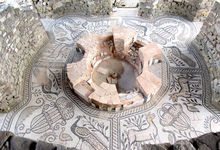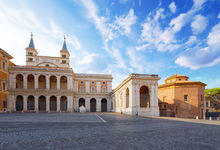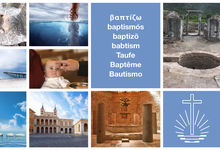The sacraments (14): Somewhere between immersion and sprinkling
Water is life. And baptism is new life. But how much water does baptism require? And how is one supposed to perform the act anyway? Theologians have arrived at three answers—and archaeologists are offering a fourth. Is there a single right answer?

The baptism of Christ: for centuries, artists have had their problems getting the right idea. Some paintings feature Jesus standing waist deep in water, and others show Him with dry feet throughout the whole event. And it’s really no wonder: after all, the painters are missing their model!
The New Testament is quite silent on how baptism was originally performed. Neither in the gospels nor in the book of Acts nor in the letters of the Apostles—let alone the moment when the sacrament was actually instituted—is the rite described as concretely as it is in the case of Holy Communion, for example.
Literally a dive
There is much to suggest that the early congregations baptised by way of immersion. The word that the New Testament uses for baptism serves as our primary piece of evidence. The uniquely Christian conglomeration baptisma derives from the general Greek baptō. And this signifies “submersion” or “immersion”—in most cases anyway.
But that does not describe the sequence of the act beyond all doubt. This is only shown by detailed linguistic analyses of the term and the context in which it appears in Holy Scripture. Quite apart from this is the fact that submersion would often have been difficult, for example, in prison, in arid regions, or during mass baptisms of 3,000 to 5,000 people at a time.
Alternatives are possible
At latest, a second variant is documented in the mother of all church orders: if the baptism was not possible in living (that is, flowing) water, then the water was to be poured three times over the head of the person being baptised. That is the prescription specified in the seventh chapter of the Didache, which came into being sometime in the first century.
The first official discussion paper on the subject, written in around the year 200, makes reference to yet another form. In addition to immersion (per immersionem) and pouring over (per infusionem), Tertullian also mentions sprinkling (per aspersionem) in his treatise De Baptismo.
What the archaeologists happened to find
And which of these three forms of baptism is the historically correct one? Probably none of them. It is likely a mixed fourth form: the person being baptised stands knee to waist deep in the water, while water is poured over his head.
Archaeologists are increasingly coming to this view of the matter, because this is the best way to explain the dimensions of the baptismal fonts that are to be found next to the earliest Christian church buildings. And this is also how the act is shown in various early depictions, for example in a Roman catacomb from the third century, on the gravestone of a girl from the year 400, or in fragments of glass from an old Roman house dating to the fourth or fifth century.
Each form with meaning and purpose
So is everything the churches are doing wrong? Not at all. After all, there are good biblical and theological reasons for all three forms, just as there are for child baptism:
- Immersion (per immersionem): the New Testament most often uses the term baptizō for “baptising”, which actually refers to the fatal version of submersion or immersion, namely drowning. This emphasises the importance of baptism as the end of the old, sinful life, and the beginning of the new life in Christ (Romans, Colossians). Immersion is practised primarily by the Orthodox Churches, the Baptists, and the churches of the Pentecostal movement.
- Pouring over (per infusionem): this form is based on a Lucan concept of baptism from the book of Acts, which considers its archetype to be the outpouring of the Holy Spirit. The cleansing character of the act emphasises the importance of baptism as the washing away of original sin. This form of pouring water over the baptised is prevalent in the Catholic, Lutheran, and Anglican Churches.
- Sprinkling (per aspersionem): the Bible of the early Christians was the Septuagint, which is the Greek translation of the Old Testament. Here, the Greek term for baptism is used to replace the original Hebrew word for sprinkling, for example in the book of Ezekiel, which makes reference to cleansing and renewal. The practice of the New Apostolic Church also adheres to this form. Here the officiant performing the baptism wets the forehead of the person being baptised three times, each time tracing the shape of the cross. But here too, the liturgical instruction applies: “It must be ensured that sufficient water is used in the process.”
Most denominations are in agreement: the amount of water used in the baptism is of secondary importance. The most important thing for properly performing the rite is what Jesus Christ Himself clearly prescribed: “[Baptise] them in the name of the Father and of the Son and of the Holy Spirit” (Matthew 28: 19).
Photo: SANKOWSKI.IT - stock.adobe.com
Article info
Author:
Date:
Keywords:
Andreas Rother
21.07.2020
sacraments,
Holy Baptism,
Doctrinal statements














